Bison Hybrids, Cattalo, and Beefalo
There is a great deal of misinformation regarding beefalo, cattalo, and hybrids that need clarification. Many think that you take a bison and put it in with some cattle, they breed, and you end up with beefalo. This misinformation is largely related to the inaccurate or out of context literature that states "Beefalo constitute a fertile hybrid offspring of domestic cattle (Bos taurus), usually a male in managed breeding programs, and the American bison (Bison bison), usually a female in managed breeding programs" (1) and simpler statements such as "Beefalo is a species cross between Bison (buffalo) and domestic cattle of any breed" (2). Before you embark on breeding cattle and bison, understand the history and the challenges of such an endeavor – it is not simply having a bison and cattle mate - they will not generally even do that.
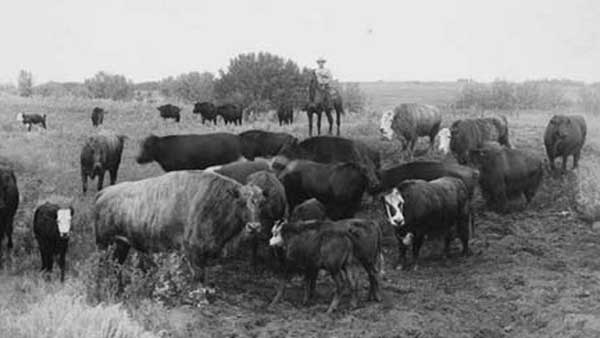
Bison-cattle hybrids at Buffalo National Park, Canada. Photo from Brower, 2008 (4).
The purpose of this article is to dismiss the notion that you can just buy a bison heifer (or bull), put it in with your cattle, and create a beefalo and to clarify some of the misinformation about bison hybrids, cattalo, and beefalo.
The cross-breeding of bison and domestic cattle has been going on for a long time as well as efforts to domesticate the animals. Early efforts to domesticate bison (wild cattle) were met with limited success. In Peter Kalm's Travels in North America Volume III (3), in 1750, he refers to wild cattle that meet the general description of bison and states:
"With this view (endeavor to tame the wild cattle), some have repeatedly got young wild calves, and brought them up in Quebec, and other places, among the tame cattle; but they commonly died in three or four years' time; and though they have seen people every day, they have always retained a natural ferocity. They have constantly been very shy, pricked up their ears at the sight of a man, and trembled, or run about; for that the art of taming them has not hitherto been found out."(3).
Elsewhere, in Philadelphia Pennsylvania in 1748, Peter Kalm notes that:
""The wild Cows and oxen, of which several people of distinction have got young calves from these wild cows, which are to be met with in Carolina, and other provinces to the south of Pennsylvania, and brought them up among the tame cattle; when grown up, they were perfectly tame, but at the same time very unruly, they likewise copulated with the latter, and by that means generated as it were a new breed."(3).
"Notwithstanding the fact that "perfectly tame" and "very unruly" would seem a bit conflicting, the accidental and unnatural breeding of bison and domestic cattle did occur when very young bison calves are raised with cattle.
The first deliberate attempt to breed bison and cattle may have been by Robert Wickliffe of Lexington, Kentucky as early as 1815 (4), but there is little information regarding these attempts. In 1880, Colonel Samuel Bedson, the warden of Stoney Mountain Penitentiary, Winnipeg, bred bison with Durham cattle to produce hybrids that were "a great improvement on both of its progenitors" (4).
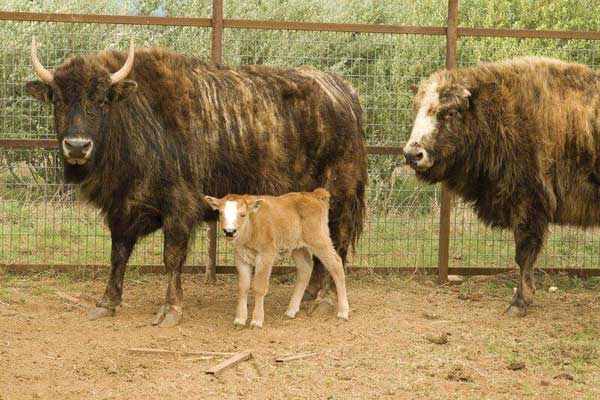
Cattalo. Bison-Hereford cattle hybrids often have brindle coats and amber horns.
By 1890 there was a surge in bison-cattle cross-breeding with Charles (Buffalo) Jones and Charles Goodnight entering the hybridization effort, followed by Michael Pablo, Charles Allard, Scotty Phillip, and others (5-9). The purpose of these efforts was to create a hardy and sturdy half-breed buffalo that could be handled as easily as ordinary cattle (5-10). The effort was to combine some of the hardihood of the bison with the beef producing qualities of domestic cattle, the so-called "bison domestic hybrid" or "cattalo". As "Buffalo" Jones said, it is not in mere domestication, but in cross-breeding that the buffalo's value consists (6,10).
Of all the ranchers involved in cattle-bison crosses, Charles (Buffalo) Jones is perhaps most credited with pushing the interest in bison-cattle hybrids, breeding bison with Galloway and Polled Angus cattle for over 20 years and making exaggerated claims of success and the benefits of the new cattle breed he called "catalo" (later changed by others to "cattalo") (6). Jones' catalo were a great improvement over other cattle breeds – they were immune to most disease, ate less and had better weight gains, did not require any feed supplementation, yielded a quality of milk as rich as that of the Jersey, could withstand extreme weather from blizzard to drought, and produced the finest fur as handsome as the black beaver - they were magnificent creatures (6).
Based on his successes and claims, in January 1906, Jones was granted a special concession by the U.S. Government to experiment with crossbreeding bison with Galloway cattle on the Grand Canyon Forest Reservation ranch located along the North Rim of the Grand Canyon in the Kaibab Plateau area of northern Arizona and produce an animal better suited to forage on its own and survive harsher winter conditions, the so-called "cattalo" (11). Under this partnership, Jones would provide the care, "know-how" and the bulk of the livestock and the government would furnished the land and, on loan, some of the animals. Both would share in the product. After only a few years, in 1908, Jones' experiments had failed and the hybrids were released and allowed to roam free. The bison of the Grand Canyon that exist today are remnants of Jones' failed cattalo experiments (12).

Charles Goodnight with a couple of his bison-cattle hybrids, "cattalo".
In 1894, Mossom Martin Boyd of Bobcaygeon, Ontario began crossing a pure buffalo bull with a variety of cattle including Polled Angus, Herefords, West Highland, Sussex, Devon, as well as grade and "scrub" cattle (5,8). As with all his predecessors, the purpose of these experiments were to produce a hardier breed of range cattle that would withstand "the severe climate of our Western Provinces, and also to combine the large carcass and fine robe of the buffalo with the better beef qualities of the domestic breeds."(4) Following Boyd's death, in December 1915 the Canadian government purchased 20 mixed blood animals from the estate of Mossom Boyd for the purpose of continuing these hybridization experiments. These animals were moved to an Experimental Farm in Saskatchewan and later moved to Buffalo National Park (4). Unfortunately, by 1925 it was discovered that none of the original hybrids bred and the experiments would need to start from scratch. By 1936, over 10 years later, the Canadian government had successfully cross-bred only 30 cattalos. The cattalo and associated experiments were ultimately moved to the Dominion Range Experiment Station in Manyberries, Alberta and aborted in 1964 (4).
So what was the problem in cross-breeding bison and cattle that all the efforts to create that hardier breed of range cattle and "bison domestic hybrid" failed?
The main problem was the difficulties in the first bison-cattle cross (the F1), both in getting the matting to occur and the issues involved if cows got bred. These problems were hidden, perhaps even fraudulently.
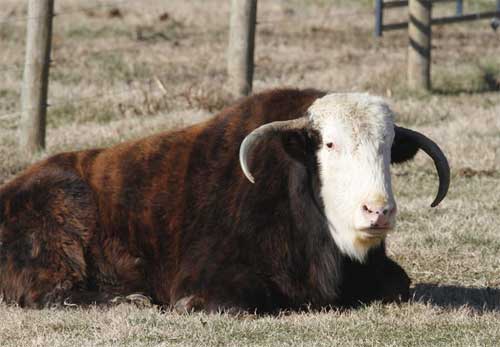
It is generally only the F1 that look like strange creatures. The F2's will look more cattle or more bison like depending on the sire.
This first problem is that bison and cattle do not naturally breed. You needed to obtain a young bison bull calf, the younger the better, and raise it exclusively with cattle. When the animal reaches sexual maturity, it may mate with cattle. Charles Goodnight would obtain newborn bull calves and allow them to nurse on cattle (9). The same situation, young cattle bull calf raised with bison, is required for the reciprocal mating; however, an adult bison cow may not allow a cattle bull to breed them (5) or the domestic bull will perhaps be afraid of the hairy cows. Thus, it is often necessary to raise both the bison and cattle calves together to insure a successful adult mating. Unless raised together from birth, a domestic bull will rarely breed a bison cow. Since it is easier to keep a single bison bull and domestic cattle cows rather than a herd of bison females, most cross-breeding experiments used a bison bull.
If a successful mating does occur, it will be accompanied with low fertility and a high rate of abortion. In addition, a large number of the pregnant females will die from what is believed to be an excessive amount of amniotic fluid (4,8), a condition known as polyhydramnios. Only females will be born. Any males born will be stillborn or die within a few hours after birth. As noted by Boyd referring to the F1 cross, "On account of the fatalities attending so severe a cross, it is however, out of the question to breed hybrids"(8).
Even "Buffalo" Jones had problems he did not readily disclose. In 1887, Jones put a 2-yr old bison bull in with his Galloway cows hoping for a hybrid calf crop. No calves were born. The following year, he reported 80-90 pregnant cows, but failed to disclose the birth of only 2 calves. Even worse, he lost 30-40% of the cows either before or while giving birth (13).
Other ranchers experienced similar problems with breeding, fertility, and loss of cows. Charles Allard in Flathead Lake, Montana, stopped his cattalo experiments because too many of his cows died. Rutherford Stuyvesant in New Jersey called it quits when 19 of his Galloway cows died calving hybrids (13). In fact, all the original ranchers that experimented with bison-cattle hybrids (cattalo) gave up on the idea after years of effort. No rancher can survive and stay in business losing 30-40% of their calf-bearing cows each year. In the end, even Buffalo Jones went bankrupt and had to sell out (13). But he went down gallantly declaring—just a little more time and his crossbreds would have made him a fortune!
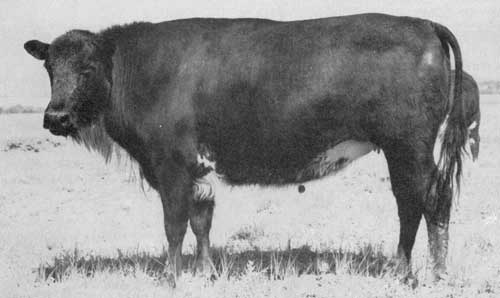
As you breed back to cattle, the hybrids begin to lose their bison features and appear more cattle-like.
Some of these problems associated with crossing a male bison with a domestic cow, particularly the low fertility and mortality rate of the cow, is somewhat alleviated by crossing a domestic bull with a bison cow. However, this reciprocal cross required maintaining a herd of wild difficult-to-handle bison cows. In addition, getting a domestic bull to mate a bison is far more difficult and the sterility issues of male calves are not circumvented. To quote Boyd in 1914 again, "On account of the fatalities attending so severe a cross, it is however, out of the question to breed hybrids"(8).
However, if you are successful in getting a few F1 hybrids, things do tend to get a little easier. The F1 females are fertile and will allegedly mate with either bison or cattle, assuming the bull is accommodating. Males born to the F1 cross are sterile as are all subsequent crosses until the amount of bison is reduced to approximately 1/8 (7-9). Mating the F1 crosses with domestic bulls rapidly gets away from all resemblance to the buffalo and vice versa, by using pure buffalo bulls one soon grades up to an animal indistinguishable from the pure buffalo.
In addition to the multitude of problems in generating the first cross, the inability to create a fertile bull with more than 1/8th bison hindered the efforts to stabilize the cattalo as a consistent cattle breed.
Generally speaking, the F1 bison-cattle cross is considered a simple hybrid. All subsequent crosses, with either cattle or bison, are considered cattalo. However, the US Code of Federal Regulations. 9 CFR 352.1(g) Definitions. 2018 states "Catalo or Cattalo means any hybrid animal with American bison appearance resulting from direct cross-breeding of American bison and cattle."(14). In Canada, cattalo is used for all bison-cattle hybrids of all degrees and appearances.
As discussed above, creating a bison hybrid or a cattalo is not a simple task. Just getting the bison and cattle to mate is a challenge and, if successful, the problems may have just begun. Taking advice from Boyd, a man with years' experience breeding bison and cattle, it is "out of the question to breed hybrids" (the first cross).
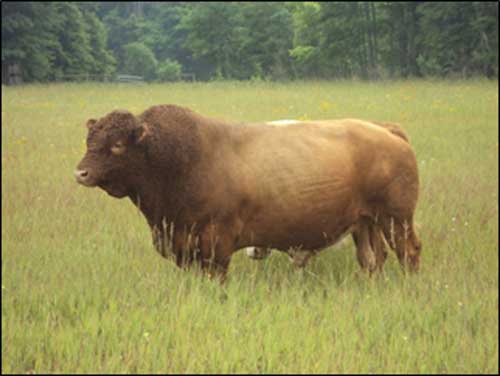
Most people think that a beefalo has obvious bison traits such as a hump and a mane, but such is more characteristic of a cattalo.
The Beefalo on the other hand is a specific registered breed of cattle that is 3/8th bison and 5/8th domestic cattle of any breed. It is not something that is created simply by breeding bison and cattle nor is it simply a "species cross between Bison (buffalo) and domestic cattle of any breed" (2). A true beefalo will generally take four generations of breeding, for a total of six to 10 years, to produce with several cross and backcrosses.
The actual origin of the Beefalo dates back to Jim Burnett of Luther Montana that, in 1957, finally produced a fertile hybrid bull (15,16). He began by mating domestic cows with bison bulls in the first cross and then mating the first cross heifers (50%) bison back to bison bulls. He had limited success mating domestic bulls with bison heifers or hybrids. His fertile bulls were thus said to be 3/4 bison (18). It is said that shortly thereafter, the World Beefalo Association introduced this new breed as "Beefalo" (15-17).
Then, in the early 70's, after 15 years and more than 1,000 experiments, D.C. ("Bud") Basolo of Tracy California announced that he has produced a herd of 5,000 hardy cow-buffalo hybrids (18). Some accounts allege that Basolo had purchased a few fertile hybrid bulls from Burnett which allowed him to produce his hybrids (19) but this is unclear.
"Buffalo Bud" made similar claims that "Buffalo Jones" did in the early 1900's - his hybrids were cheaper to feed and more resistant to disease, fatten faster than regular steers, and readily reproduced. Basolo managed to get the story of his hybrids published in an article entitled "Business: Have a Slice of Roast Buffalo" which appeared in the July 09, 1973 issue of Time magazine (18). Basolo also patented the names "beefalo", "Basolo", and "Basolo hybrid" as well as the World Beefalo Association (20). Mr. Basolo sold his special beefalo sperm to hundreds of ranchers and in 1975 made the Guinness Book of World Records for the most expensive cattle (21). Basolo sold his 3/8 bison, 3/8 Charolais and 1/4 Hereford Beefalo to the Beefalo Cattle Co. of Calgary, Alberta, Canada on September 9, 1974 for $2.5 million (21). It is unclear how Basolo created his F1 hybrids, whether he mated bison bulls to domestic cattle heifers or domestic bulls to bison heifers, or he obtained semen from Burnett or someone else.
The histories of Jim Burnett and D.C. Basolo, how they created their beefalo, their fertile bulls, and their true contributions to the beefalo breed are a bit murky at best.
The World Beefalo Association was founded in California as a Domestic Corporation on September 16, 1974 (currently listed as suspended)(22) and the American Beefalo Association (23) was founded on July 31, 1975 as a Kentucky Domestic Corporation. In 1980 the National Cattlemen's Association recognized the breed in its official roster and USDA considered "Beefalo" to be its own brand of beef.
It is interesting to note that, after thousands of attempts over so many years in the early 1900's that failed to create a viable cattalo breed by cross-breeding bison and cattle, doing the exact same thing as before, all of a sudden fertile F2 hybrid bulls becomes possible. It is said that these F2 fertile bison hybrid bulls made the creation of the Beefalo possible. Perhaps the definition of insanity in "doing the same thing over and over again and expecting a different result" does not apply here because they did the same thing. Also, as can be seen below, these alleged 75% fertile bison bulls are not needed to create the full blood beefalo.
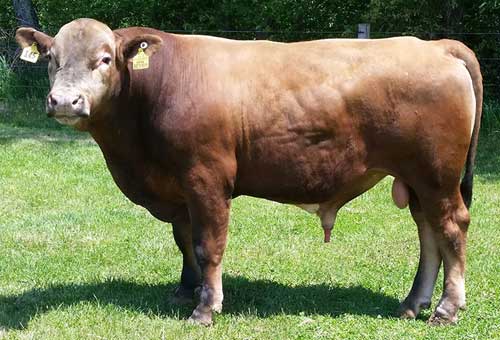
The Full Blood Beefalo of today is more cattle-like as breeding efforts have diminished many of the bison physical traits while maintaining the bison benefits.
The new name, Beefalo, was meant to separate this hybrid from the problems associated with the old cattalo hybrids, although the only real difference is that the beefalo has a defined percentage of bison blood. Beefalo are primarily cattle in genetics and appearance and are readily distinguishable from bison hybrids, cattalo, and even most other cattle breeds.
Many of the claims made by the original Cattalo developers are reiterated by the Beefalo ranchers in that the Beefalo is better able to tolerate the cold, ease in calving, docile nature, and fast growth rates as compared to conventional cattle. USDA confirmed that Beefalo produce lean meat qualities, low cholesterol, and high in protein, calcium, and iron (24). As a result, USDA recognizes "Beefalo" as its own brand of beef.
In accordance with the USDA guidelines, in order to sell meat under the Beefalo brand name, animals must be registered with the American Beefalo Association (24). Animals may be registered as:
- Full Blood Beefalo. These animals are exactly 3/8 (37.7%) bison and 5/8 (62.5%) cattle of any breed or combination of breeds.
- PureBred Beefalo. These animals are 34% or more bison but less than 37.5% bison. The cattle content may be of any breed of cattle or any combination of breeds.
- Percentage Beefalo. Beefalo percentage animals are those animals used for breeding stock having bison percentages, by breeding, of at least 17% and below 37.5%. These include the "half-bloods" at 19%.
- Ancestry Animals. These animals are reference animals that may be used for future breeding and include animals with more than 37.5% bison or less than 17% bison. F1 bison-cattle hybrids (50%:50%) would fall into this category.
- Grandfathered Animals. These animals were previously registered in the American Beefalo Association (ABA), The International Beefalo Federation, American Beefalo International, or American Beefalo World Registry prior to the effective date of the ABA Rules of Registry are grandfathered in the definitions used by those association
- Beefalo Meat. These animals have 17% or more bison, but not more than 37.5%. The meat from these animals may be sold under the Beefalo breed.

The Full Blood Beefalo of today is more cattle-like as breeding efforts have diminished many of the bison physical traits while maintaining the bison benefits.
Most Beefalo today are created through artificial insemination thereby circumventing the issues in creating the F1 hybrids. Ranchers that already own domestic cattle can purchase semen from Full Blood Beefalo bulls and artificially breed their standard cattle stock to produce a Half-Blood or Percentage Beefalo (19% bison) and sell the offspring meat as Beefalo. Then, by breeding the hybrid females back to Full Blood Beefalo bulls (37.5% bison) for two or more subsequent generations, you can obtain PureBlood Beefalo (34% bison).
Alternately, you can start from scratch and create your own Beefalo blood line (25). It will take at least four generations of breeding, a total of six to 10 years, to produce a certifiable Full Blood Beefalo. Start by getting a pure bison calf and a cattle calf of your chosen breed. The younger the better and raise them together until breeding age. Preferably a young bull and several heifer calves, because fertility is low and males will likely abort. Hopefully the will breed. If not, try again. Using a domestic bull calf will reduce some of the heifer losses due to polyhydramnios, but will require you to keep a bunch of unruly bison calves and increase the chances the bull will not breed. You can try throwing in a young bison bull in with your cattle and you might get lucky and have him breed your cows, but it would be rare.
If you have a successful mating and some births, your F1 will be all female and 50% bison- 50% cattle hybrids. You can now breed your F1 heifers to your original bison bull (father to daughter) or, if your F1 heifers were from a domestic cattle bull mating, you need to buy a pure bison bull to breed to your F1 heifers to create your 25% cattle/75% bison (i.e., 50% hybrid X pure bison = 25% cattle/75% bison hybrid). These will also likely to be all females or sterile males. Now you can breed your cattle bull to the 75% bison hybrid female to produce your 37.5% Full Blood Beefalo.
| Breed | Result | Offspring | |
|---|---|---|---|
| F1 | 100% Bison X 100% Cattle | 50% bison 50% cattle | Females only |
| F2 | 50% Bison/Cattle (F1) X 100% Bison Bull | 75% bison 25% cattle | Mostly Female Some sterile bulls |
| F3 | 75% bison (F2) X 100% Cattle Bull | 37.5% bison 62.5% Cattle | Full Blood Beefalo |
As you can see, you will need at least one cooperative bison bull and one cooperative cattle bull. You will also need several female heifers, either bison or cattle, for your first F1 cross because of the low fertility and only female births. Since male bison and cattle do not like to breed the other species and heifers do not like to be bred by the other species, the greatest success is raising them all together from calves – make the bison think they are cattle and the cattle think they are bison. Otherwise breeding will likely be hit or miss with more misses than hits. You would probably want to start with at least 6-10 animals.
It is interesting to note from the above breeding scheme that creating a fertile F2 male hybrid, as stated in many writings as the "breakthrough" needed to create the beefalo, has no relevance to the breeding of a Full Blood Beefalo. This was/is probably misinformation or propaganda.
It is interesting to note from the above breeding scheme that creating a fertile F2 male hybrid, as stated in many writings as the "breakthrough" needed to create the beefalo, has no relevance to the breeding of a Full Blood Beefalo. This was/is probably misinformation or propaganda.
From the above, it should be clear that bison hybrids, cattalo, and beefalo are not all the same and that it is not the simple task of putting a bison heifer in with your cows or buying a bison bull and expecting him to breed your domestic cows. It is an effort successful for a few and disastrous by many.
Ozark Valley Bison Ranch LLC
Fox, AR
Literature Cited
1. Wikipedia. Beefalo. https://en.wikipedia.org/wiki/Beefalo. Retrieved January, 2022.
2. Breeds of Livestock – Beefalo Cattle. http://afs.okstate.edu/breeds/cattle/beefalo
3. Kalm P. 1771. Travels into North America. Vol. III. Translated into English by Foster, J.R., T. Lowndes, Eds, London.
4. Brower J. 2008. Lost Tracks. National Buffalo Park, 1909-1939. Chapter 5. Evolving the Artic Cow. AU Press, Athabasca University, Edmonton, AB.
5. Boyd, M.M. 1908. Crossing Bison with Cattle. A Short Account of an Experiment in Crossing the American Bison with Domestic Cattle. American Breeders' Association. Vol, IV. Pp 324-331
6. Jones C. J. 1907. Breeding Cattelo. American Breeders' Association Annual Report, Vol. III. Page 161.
7. Dafoe, J.W. 1889. Domestication of the buffalo. Popular Science Monthly. 34:777-782
8. Boyd, M.M. 1914. Crossing Bison and Cattle. J. Hered. 5:189–197.
9. Goodnight C. 1914. My experience with bison hybrids. J. Hered. 5:197–199.
10. Jones C.J. 1899. Buffalo Jones' Forty Years of Adventure; A volume of facts gathered from experience. Compiled by Inman H. Crane & Co., Topeka, KS.
11. National Park Service, U.S. Department if the Interior. 2021. Bison at Grand Canyon National Park. https://www.nps.gov/articles/bison-history-at-grand-canyon-national-park.htm . Retrieved Jan. 2022.
12. Minard, A. 2003. The Grand Canyon's Cattalo. Science 302(5645):549. Available at: https://www.science.org/doi/10.1126/science.302.5645.549b
13. Barsness L. 1985. Heads, Hides and Horns: The Complete Buffalo Book. Texas Christian University Press, Fort Worth, TX. ISBN: 9780875650081
14. United States Code of Federal Regulations. 9 CFR 352.1(g) Definitions. 2018. Available at: https://www.law.cornell.edu/cfr/text/9/352.1
15. American Beefalo Association. http://americanbeefaloassociation.com/aboutaba/ Retrieved January 2022.
16. Thomas H.S. 2019. Backyard Basics: Crossbreeding bison: The Beefalo. https://www.postregister.com/farmandranch/columnists/barnyard_basics/barnyard-basics-crossbreeding-bison-the-beefalo/article_64c157df-bb80-59f7-9ab8-a8fdec19a029.html Retrieved January 2022.
17. Irvine K. 2019. Beefalo Cattle Breed – Everything you need to know. https://domesticanimalbreeds.com/beefalo-cattle-breed-everything-you-need-to-know/ Retrieved January 2022.
18. Time Magazine. 1973. Business: Have a Slice of Roast Beefalo. http://content.time.com/time/subscriber/article/0,33009,907530,00.html Retrieved January 2022.
19. The Weller Farm. A short history of Beefalo. http://www.ctq2.org/beefalo/a-short-history-of-beefalo/ Retrieved January 2022.
20. Trademark Electronic Search System (TESS), United States Patent and Trademark Office. https://www.uspto.gov/trademarks/search Retrieved January 2022.
21. Guinness World Records 2022. https://www.guinnessworldrecords.com/world-records/70817-most-expensive-cattle Retrieved January 2022
22. California Secretary of State. Business Search. https://businesssearch.sos.ca.gov/ Entity No. C0722214 . World Beefalo Association. Retrieved January 2022.
23. Kentucky Secretary of State. Business Organization Search. American Beefalo Association. https://web.sos.ky.gov/ftsearch/ Retrieved January 2022
24. American Beefalo Association. http://americanbeefaloassociation.com/ Retrieved January 2022
25. Leo Muehr, President, American Beefalo Association. Personal Communication, January 2022.
